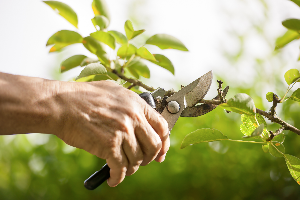A healthy landscape, including lawn and trees, can withstand a few insect pests with little to no visible damage. The problem occurs when a pest is able to take advantage of a weakness in your plants or in your landscape design. Don’t be guilty of putting your landscape in danger: make sure these four things aren’t a problem in your yard.
Problem #1: Drought Disasters
Drought stress is the number one reason that plants in the landscape become susceptible to pests they could normally withstand. Everything from lawn insects to major tree pests, like the ash borer, are more likely to cause widespread destruction if trees are already weakened from drought stress.
Solution
The solution begins with knowing the signs of drought stress:
- Brown or dry spots in the lawn
- Weak or shallow root systems
- Yellow leaf margins on trees
- Wilting foliage
- Premature browning and dropping of leaves
- Roots rising to the surface
Once drought stress is identified, steps must be taken to counteract it. Installation of a sprinkler system or developing a more suitable watering schedule is one option. Aerating and dethatching the lawn so that moisture can better reach plant roots can also be helpful. Landscape alterations, including the use of mulch and the removal of water-hungry plants, may also be advisable.
Problem #2: Problem Pruning
Improper pruning can also lead to a myriad of landscape troubles. Trimming in the wrong season, for example, can cause sap to run and allow pests to invade the tree. Cutting out the wrong branches also weakens trees and plants, making them less pest resilient.
Solution
Knowing when to prune and then doing it in the right season is the only solution. As a general rule, pruning should only be done for one of two reasons:
- To remove dead or damaged areas
- To control size or shape
Most trees, both evergreen and deciduous, are best pruned in the dormant winter season. In fact, pruning an actively growing tree like an ash, for example, could make the tree more prone to an ash borer infestation.
Pruning should also mainly be done to remove dead, damaged, or poorly growing wood. Light pruning may also be used to shape or thin out the canopy of a tree, but aggressive pruning tends to weaken the plant. The best choice is always to hire a professional tree trimming service.
Problem #3: Mulch Mishaps
Mulch is considered a key method for conserving soil moisture and preventing weed invasion—two things vital to keeping insect pests away. Yet, improper mulching can cause rot, fungus, or even pest issues.
Solution
It’s all in the technique. To keep down weeds, mulch needs to be laid about two inches thick. This is sufficient for holding in soil moisture. Any thicker and the wood chips decompose slowly, which makes them more likely to develop fungal growths that can spread to and weaken plants.
You also need to protect your woody plants. Mulch should never rest against a tree trunk. This will give insect pests direct access from the mulch to the tree. Also, moisture in the mulch can cause bark to rot.
Problem #4: Fertilizer Follies
Proper plant nutrition can be a huge challenge for a homeowner. Too much fertilizer and the excess nutrients feed weeds and insect pests. Too little fertilizer and plants become stressed and more prone to falling prey to an insect infestation.
Solution
There is a very simple solution to fertilizer problems—soil testing. A professional soil test, performed every one to two years, will determine exactly which nutrients your trees and lawns need.
Follow the test with professional fertilization. DIY fertilizers are pre-formulated. While you may be able to find mixes that provide the exact amount of main nutrients you need—nitrogen, phosphorus, and potassium—it’s unlikely that you will find a blend that also provides for all of your landscape’s trace nutrient needs.
Proper landscape care and management is necessary for much more than just aesthetic value. Opting for professional lawn and tree care also ensures your landscape investment remains healthy and pest-free.
